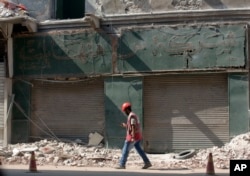Egypt levels the historic Cairo neighborhood, disgruntled residents
CAIRO –
Egyptian authorities destroy a historic district from the 19th century in Cairo
The Maspero district is named after the French Egyptologist Gaston Maspero, who helped found the Egyptian Museum. Developers have long kept an eye on the central district, which already houses the Foreign Office and the state television and radio building.
The neighborhood is part of the modern city that Khedive Ismail built in the 19th century.
Like much of the Egyptian capital, the district has been falling into decay over the past few decades. While some of the old architecture is preserved, including apartments that were inhabited by middle-class families, parts of Maspero resembled a barracked town.
Heavy machines are used to demolish buildings in the Maspero district in Cairo, Egypt, July 31, 2018. Egyptian authorities are demolishing the neighborhood to make way for development and anger residents who say they have not been adequately compensated.
Authorities spent years convincing local residents and shopkeepers to leave the area in exchange for compensation or temporary housing elsewhere, with promises to return to the neighborhood after modern housing was built.
Of the 4,500 families displaced by the demolition, around 900 will return to Maspero in apartments next to glittering apartment towers and office skyscrapers.
The redevelopment is part of a larger effort to transform Cairo, which has 20 million inhabitants, while a new administrative capital is being built in the desert 45 kilometers east.
Authorities say the projects are needed to reduce the overcrowding, traffic and pollution that has long plagued the city. However, critics say that poor Egyptians and middle-class Egyptians are being ousted by well-connected business people.
The government is targeting two Nile islands home to poor neighborhoods and farming communities in hopes of converting them into luxury residential and business districts. Again and again there were clashes with residents by the police, who issued evacuation notices.
Last week, the Governor of Cairo said Maspero had been fully evacuated, paving the way for the final phase of the demolition. “Build houses for them [900] Families will be the first phase of the project, ”said Governor Atef Abdel-Hameed.
The entire process is estimated to cost an estimated $ 225 million, according to the Housing Department.
One of the victims of the new building is the Hinhayat watch shop, which was founded in 1907 by a Bulgarian craftsman.

A worker walks past the Hinhayat watch shop, which was founded in 1907 by a Bulgarian craftsman and will be removed from the Maspero district of Cairo, Egypt on August 11, 2018.
Essam Ahmed, the owner, says his grandfather worked in the shop and bought it in 1956 when Egypt’s foreign communities fled in the face of growing nationalism and property expropriation by the socialist government. He boasts that his grandfather once repaired watches from King Farouk, the last monarch of Egypt, as well as from politicians and celebrities.
“Here’s the legacy of this store,” he said as he wrapped up the last of his watches earlier this month. “I wanted to save this legacy for the country … but it seems they are [the government] are not interested. There are things that are more important than money. ”
Ahmed has sued the government, stating that the store should have been spared demolition because of its historical value. He said authorities told him that he would only be compensated if he closed his cases.
He and other shopkeepers nearby say the compensation offered by the government for their stores – £ 7,000 ($ 391) per square meter – is well below market value in the area.
“Your compensation, which we have not yet received, is worthless,” said Ahmed. “Our livelihood is gone.”
The government insists that the compensation offered is fair and denies that it has forcibly relocated anyone.
Ahmed el-Sayed, a 63-year-old retired, moved away from Maspero months ago. He says the now demolished residential building in which he spent most of his life was a unique architectural landmark registered with the Ministry of Culture.
“It shouldn’t have been demolished. It should have been renovated,” he said.


Comments are closed.